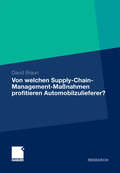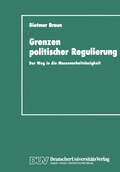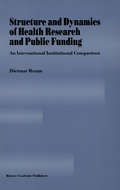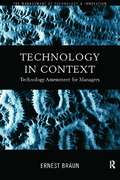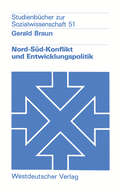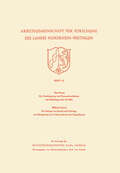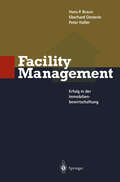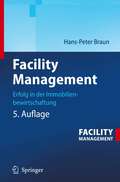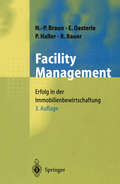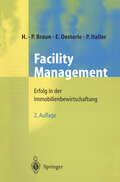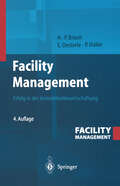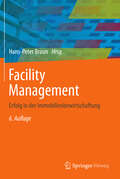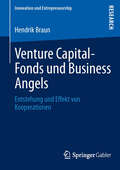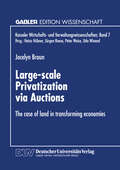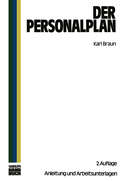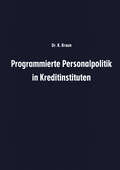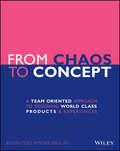- Table View
- List View
Von welchen Supply-Chain-Management-Maßnahmen profitieren Automobilzulieferer?: Eine wertorientierte Analyse an der Schnittstelle zwischen Zulieferer und Automobilhersteller
by David BraunNicht zuletzt aufgrund der geringen Fertigungstiefe bei den Automobilherstellern spielen Optimierungen durch Supply Chain Management (SCM) in der Automobilindustrie eine herausragende Rolle. David Braun leitet systematisch ab, welche SCM-Maßnahmen in den Unternehmen der Automobilindustrie Anwendung finden, und welche darüber hinaus denkbar sind. Er zeigt, von welchen SCM-Maßnahmen sowohl Automobilzulieferer als auch Automobilhersteller vor dem Hintergrund einer Make-to-Stock- und einer Build-to-Order-Supply-Chain profitieren. Zu diesem Zweck wird ein Bewertungsmodell für SCM-Maßnahmen entwickelt, welches sich zur Anwendung in der Unternehmenspraxis eignet.
Grenzen politischer Regulierung: Der Weg in die Massenarbeitslosigkeit am Beispiel der Niederlande
by Dietmar BraunStructure and Dynamics of Health Research and Public Funding: An International Institutional Comparison
by Dietmar BraunBy gathering institutional details on funding and health research systems in a comparative perspective, Structure and Dynamics of Health Research and Public Funding offers, for the first time, a comprehensive and systematic view of the options and restrictions to which scientists, clinicians and administrators are subject when seeking to establish a productive health research enterprise. The Structure and Dynamics of Health Research and Public Funding provides the reader with a comparative institutional analysis of problems of application in health research. In assessing the cognitive, social and institutional structuring of health research, explanations for the origin and variation of problems are presented. The study extensively discusses the capacities of funding agencies to contribute to a higher practical diffusion of health research knowledge. It is thus addressed to all individuals and institutions who are involved in the promotion of, or are concerned with, the future of health research.
Technology in Context: Technology Assessment for Managers (The\management Of Technology And Innovation Ser.)
by Ernest BraunMost managers know very little about the technology they introduce into their firms, often preferring to leave such decisions to a small band of technological 'experts'. As a result large amounts of time and money are often wasted on inappropriate and inefficient systems. The cost of retraining and reorganising can also be prohibitive if the new technology does not deliver the desired results. In a business environment where technology is of increasing importance, the non-technical manager cannot afford to remain in the dark. Technology in Context provides a toolkit of approaches to this difficult subject. Subjects covered include: * the fundamental concepts required for the management of technology * the gathering of information in a firm to support strategic decisions on technology * technology assessment in the public domain * the wider social implications of technology * problems associated with technology, from the danger of environmental degradation to employment and skills.
Technology in Context: Technology Assessment for Managers
by Ernest BraunMost managers know very little about the technology they introduce into their firms, often preferring to leave such decisions to a small band of technological 'experts'. As a result large amounts of time and money are often wasted on inappropriate and inefficient systems. The cost of retraining and reorganising can also be prohibitive if the new technology does not deliver the desired results. In a business environment where technology is of increasing importance, the non-technical manager cannot afford to remain in the dark. Technology in Context provides a toolkit of approaches to this difficult subject. Subjects covered include: * the fundamental concepts required for the management of technology * the gathering of information in a firm to support strategic decisions on technology * technology assessment in the public domain * the wider social implications of technology * problems associated with technology, from the danger of environmental degradation to employment and skills.
Genese natürlicher Entscheidungsprozesse und Determinanten kluger Entscheidungen: Theoretische und empirische Reflexionen im Spannungsfeld zwischen analytisch-bewusstem und intuitivem Entscheiden
by Frank Braun Patrick BenzMenschen sind, egal ob im privaten oder im beruflichen Bereich mehr oder weniger ständig damit konfrontiert, Entscheidungen treffen zu müssen und es ist evident, dass es für Entscheidungsträger von großem Vorteil wäre, wenn es gelingen könnte, möglichst viele ‚gute‘ und möglichst wenige Fehlentscheidung zu treffen. Umso überraschender ist es, dass die vergleichsweise einfach anmutende Frage: „Wie sollte ein Entscheider in einer spezifischen Entscheidungssituation methodisch betrachtet vorgehen, um zu einer möglichst ‚guten‘ Entscheidung zu gelangen?“ auch nach Jahrzehnten intensiver Forschungsbemühungen nur unzureichend beantwortet ist. Im vorliegenden Buch wird die oben formulierte Fragestellung aus einer besonderen Perspektive betrachtet, es werden nämlich sowohl analytisch-bewusste als auch intuitive Formen des Entscheidens untersucht. Insbesondere im Bereich der Ökonomie wird intuitives Entscheiden nicht selten als ‚nicht-rational‘ angesehen bzw. qualifiziert. Warum dies so ist, ob diese Zuweisung zu Recht besteht und ob die Ökonomie möglicherweise gut daran täte, ihre Position zu überdenken, wird im Buch erörtert.
Nord-Süd-Konflikt und Entwicklungspolitik: Eine Einführung (Studienbücher zur Sozialwissenschaft #51)
by Gerald BraunVerhandeln in Einkauf und Vertrieb: Mit System zu besseren Konditionen und mehr Profit
by Gerold BraunVerhandlungstechnik ist eine mehr und mehr gefragte Fähigkeit bei Ein- und Verkäufern. Der Autor gibt Praktikern in Einkauf und Vertrieb eine griffige, leicht lern- und umsetzbare Technik an die Hand, mit der sie in Verhandlungen ihre Ziele schneller und häufiger als bisher durchsetzen.
Verhandeln in Einkauf und Vertrieb: Mit System zu besseren Konditionen und mehr Profit
by Gerold BraunWer in Einkauf und Vertrieb punkten will, muss in Verhandlungen das Beste für das eigene Unternehmen herausholen. Doch viele kennen keine Methodik, die ihnen zuverlässig zum Erfolg verhilft. Dieses Buch stellt ein leicht erlernbares und schnell umsetzbares Verhandlungssystem vor, mit dem es gelingt, Verhandlungspartner geschickt zu beeinflussen und auch schwierige Fälle zu meistern. Mitarbeiter in Einkauf und Vertrieb erfahren, wie sie souverän in die erste Runde starten, die Führung übernehmen, gekonnt den Verhandlungsrahmen bestimmen und ihre Angebote attraktiv gestalten. Ein kompakter Kurs mit konkreten Handlungsanweisungen für alle, die in ihren Verhandlungen bessere Konditionen und mehr Profit erzielen wollen Außerdem: Die 7 goldenen Regeln als Sofort-Programm. Neu in der 2. Auflage: Erfolgreich verhandeln in Gruppen – wie man die Rolle des Leaders übernimmt.„Das Buch lässt keine Fragen offen, welche Schritte eine Verhandlung durchläuft und wie man sich hier richtig verhält. [...] Lesenswert!“ www.pressearbeit.de
Die Verschleppung von Pflanzenkrankheiten und Schädlingen über die Welt. Der Beitrag von Genetik und Züchtung zur Bekämpfung von Viruskrankheiten der Nutzpflanzen (Arbeitsgemeinschaft für Forschung des Landes Nordrhein-Westfalen #32)
by Hans BraunFacility Management: Erfolg in der Immobilienbewirtschaftung
by Hans P. Braun Peter Haller Eberhard OesterleFacility Management: Erfolg in der Immobilienbewirtschaftung
by Hans-Peter Braun5., neu bearbeitete Auflage des Standardwerks zu Nutzen, Hilfsmitteln und Werkzeugen des Facility Management: kostenstellenorientiertes Flächenmanagement, die technische Bewirtschaftung des Gebäudebestandes sowie verschiedene Ausgangssituationen bei Neubauprojekten und bestehenden Objekten. Grundlage der Darstellung ist der Aufbau eines Gebäudeinformationssystems zur Bereitstellung der frühzeitigen, gezielten und umfassenden Information.
Facility Management: Erfolg in der Immobilienbewirtschaftung
by Hans-Peter Braun Johannes Pütter Eberhard Oesterle R. Bauer Peter HallerFacility Management: Erfolg in der Immobilienbewirtschaftung
by Hans-Peter Braun Johannes Pütter Eberhard Oesterle Peter HallerSeit der ersten Veröffentlichung dieses Buches 1996 konnte sich am Markt keine einheitliche Begriffsdefinition für Facility Management durchsetzen, im Gegenteil: Die Interpretation dieser Leistung driftet immer weiter auseinander. Die Autoren möchten mit dieser überarbeiteten Auflage jedoch keine neue Grundsatzdiskussion über Facility Management entfachen. Wichtig ist nur, den Trend und die damit verbundene Trennung in strategisches und operatives Facility Management aufzugreifen und inhaltlich abzugrenzen. Entscheidend ist dabei, welche Organisationsform ein Unternehmen hat und wie moderne Informationssysteme eingesetzt werden können.
Facility Management: Erfolg in der Immobilienbewirtschaftung
by Hans-Peter Braun Johannes Pütter Eberhard Oesterle Peter HallerFacility Management: Erfolg in der Immobilienbewirtschaftung
by Hans-Peter Braun Martin Reents Peter Zahn Patrick WenzelDer Management-Leitfaden zur Einführung und Umsetzung von Facility Management erscheint bereits in der 6. Auflage. Die Neubearbeitung der Themen reicht von der nachhaltigen Gebäudebewirtschaftung über die Problematik bei der Einführung einer elektronischen Gebäudeakte, bis hin zur Produktionssteigerung mit Hilfe eines CAFM-Gebäudeinformationssystems und trägt damit dem heutigen Stand der Technik Rechnung. Das Buch gibt Antworten auf folgende Fragen:- Welchen Nutzen bietet ein nachhaltiges Facility Management?- Welche Hürden gilt es bei der Umsetzung und Einführung zu beachten?- Wodurch werden Kosteneinsparungen erzielt?- Welche Hilfsmittel und Werkzeuge eignen sich am besten?
Venture Capital-Fonds und Business Angels: Entstehung und Effekt von Kooperationen (Innovation und Entrepreneurship)
by Hendrik BraunIm Mittelpunkt des Forschungsvorhabens steht die Frage nach der Entstehung und dem Effekt von Kooperation zwischen Venture-Capital-Fonds und Business Angels. Ausgangspunkt zur Beantwortung der Frage in Hinsicht auf die Entstehung bildet die Analyse bestehender Investitionsbeziehungen. Hier zeigt sich, dass die Wahrscheinlichkeit von Kooperation zwischen den Kapitalgebern im Zusammenhang mit deren Charakteristika besteht. In Hinsicht auf den Effekt wird die Frage durch die Untersuchung zweier Fallbeispiele von Kooperation beantwortet. Anhand von Daten über die Quellen von Investitionsmöglichkeiten lässt sich in beiden Fällen ein positiver Effekt von Kooperation zeigen. Die Untersuchung der beiden Aspekte von Kooperation erfolgt vornehmlich aus der Perspektive von Venture-Capital-Fonds.
Marginality: Addressing the Nexus of Poverty, Exclusion and Ecology
by Joachim Braun Franz W. GatzweilerThis book takes a new approach on understanding causes of extreme poverty and promising actions to address it. Its focus is on marginality being a root cause of poverty and deprivation. “Marginality” is the position of people on the edge, preventing their access to resources, freedom of choices, and the development of capabilities. The book is research based with original empirical analyses at local, national, and local scales; book contributors are leaders in their fields and have backgrounds in different disciplines. An important message of the book is that economic and ecological approaches and institutional innovations need to be integrated to overcome marginality. The book will be a valuable source for development scholars and students, actors that design public policies, and for social innovators in the private sector and non-governmental organizations.
Large-scale Privatization via Auctions: The case of land in transforming economies (Kasseler Wirtschafts- und Verwaltungswissenschaften #7)
by Jocelyn BraunOn the basis of a game-theoretic framework of analysis, Jocelyn Braun shows that the mechanism of auctioning is an efficient and equitable alternative to many privatization methods that have so far been implemented with disappointing results.
Programmierte Personalpolitik in Kreditinstituten: Arbeitsunterlage für Führungskräfte und Mitarbeitervertreter zur erfolgsbezogenen Planung des Personalbereichs ihres Instituts
by Karl BraunMarketing- und Vertriebspower durch Sponsoring: Sponsoringbudgets strategisch managen und refinanzieren
by Karl Braun Dirk Huefnagels Thomas Müller-Schwemer Gabriele SorgWas ist Sponsoring? Ein Millionengrab? Ein Jahrmarkt der Eitelkeiten für medienverliebte Manager? Das spannendste Kommunikations- und Marketinginstrument der Welt? Der intelligenteste Ansatz, eine Marke zu emotionalisieren? Nur eine PR-Masche? Oder womöglich viel mehr als PR- und Imagepolitik? Sicher ist: Sponsoring kostet Geld – zunächst. Unternehmen, die in der int- nationalen Sport- und Medienwelt präsent sein wollen, müssen immer höhere Sponsoring-Budgets bereitstellen. Aber: Sponsoring ist eine Inves- tion, die sich fast immer rechnet. Und: Unternehmen schaffen über das Sp- soring für Kunden und Geschäftspartner einmalige Erlebniswelten und - durch ein positives, emotionales Umfeld, um auf verschiedenen Ebenen des Managements neue, förderliche Kontakte zu knüpfen, zu pflegen und zu vertiefen. Was ist eine der größten Sponsoring-Herausforderungen? Eine der größten Herausforderungen ist, Sponsoring strategisch zu managen und es messbar, planbar, prognostizierbar und mit anderen Plattformen zur Erreichung strategischer Ziele vergleichbar zu machen. Wie andere Kommunikations- und Marketing-Plattformen auch, muss sich das Sp- soring den analytischen Augen des Controllings stellen und seine Ex- tenzberechtigung nachweisen. Dazu reicht es nicht mehr aus, mit einem Lächeln zu behaupten, dass so mancher Auftrag bei einem Glas Champ- ner anlässlich eines sportiven oder medialen Großereignisses unter Dach und Fach gebracht wurde. Sponsoren und Gesponserte sind zunehmend aufgefordert, Erfolg und Wirtschaftlichkeit ihrer Sponsoring-Engagements anhand nachvollziehbarer Zahlen unter Beweis zu stellen. Das erfordert umzudenken und Sponsoring nicht ausschließlich als Kommunikatio- und/oder Marketing-Plattform zu sehen, sondern als integrierte Kommu- kations-, Marken-, Marketing- und Vertriebs-Plattform zur Erreichung st- tegischer Unternehmensziele.
From Chaos to Concept: A Team Oriented Approach to Designing World Class Products and Experiences
by Kevin Collamore BraunThis book is written for product design, software development, graphic design, and UX professionals with a focus on creating measurably better user experiences. If you want to design solutions to meet business goals and delight your users, you can look to this resource which covers the following areas: Creating and documenting goals, strategies, objectives, and tactics Defining or refining personas based on your measurable objectives (OKRs) Creating and iterating on scenarios based your prioritized personas A team approach to defining the product and roadmap to address critical use cases Team based divergent ideation and solution exploration Team based convergent solution definition Wireframing potential solutions for rapid research and iteration Using quantitative and qualitative methods to understand usage and test with users Exploring approaches to taxonomy and information architecture Using psychology and human factors to drive your design decisions Developing performant, accessible, maintainable experiences Using analytics to measure the results and inform the next iteration How this process differs based on the size of the company or team that is employing it
From Chaos to Concept: A Team Oriented Approach to Designing World Class Products and Experiences
by Kevin Collamore BraunThis book is written for product design, software development, graphic design, and UX professionals with a focus on creating measurably better user experiences. If you want to design solutions to meet business goals and delight your users, you can look to this resource which covers the following areas: Creating and documenting goals, strategies, objectives, and tactics Defining or refining personas based on your measurable objectives (OKRs) Creating and iterating on scenarios based your prioritized personas A team approach to defining the product and roadmap to address critical use cases Team based divergent ideation and solution exploration Team based convergent solution definition Wireframing potential solutions for rapid research and iteration Using quantitative and qualitative methods to understand usage and test with users Exploring approaches to taxonomy and information architecture Using psychology and human factors to drive your design decisions Developing performant, accessible, maintainable experiences Using analytics to measure the results and inform the next iteration How this process differs based on the size of the company or team that is employing it
Across the Sahara: Tracks, Trade and Cross-Cultural Exchange in Libya
by Klaus Braun Jacqueline PassonThis open access book provides a multi-perspective approach to the caravan trade in the Sahara during the 19th century. Based on travelogues from European travelers, recently found Arab sources, historical maps and results from several expeditions, the book gives an overview of the historical periods of the caravan trade as well as detailed information about the infrastructure which was necessary to establish those trade networks. Included are a variety of unique historical and recent maps as well as remote sensing images of the important trade routes and the corresponding historic oases. To give a deeper understanding of how those trading networks work, aspects such as culturally influenced concepts of spatial orientation are discussed. The book aims to be a useful reference for the caravan trade in the Sahara, that can be recommended both to students and to specialists and researchers in the field of Geography, History and African Studies.
